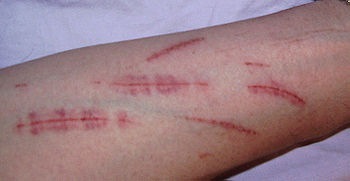| Self-harm (Photo credit: Wikipedia) |
Is your adolescent, teenager or young adult child trying to hide their scars?
A provocative question for sure, but think about it for a minute. We are talking about physical scars from cutting (or burning), not just emotional scars.
Hiding any kind of scar is not unusual. Women wear make-up to hide acne scars or brown spots. People will choose various clothing styles to cover up healed wounds from surgeries or injuries. But hiding scars from cutting can be an exhaustive full time job for any teenager or young adult who is trying to appear “well.”
In the not so recent past, people looking to hide their scars may have only concluded that a long sleeved shirt or blouse was the obvious solution. However, in today’s world of social media various networks have become the “go-to” resource on not only how to hide the resultant scars, but even how to cause the scars –self harm.
Tucson News Now seeks answers from Cottonwood Tucson Clinical Director
Self harm is in the news lately. You might remember we published a post in early May 2014 about a new study linking high antidepressant doses with self harm when treating children and young adults.This week Tucson News Now, the Internet home for KOLD the CBS affiliate in Tucson and KMSB the FOX affiliate in Tucson, contacted Cottonwood Tucson‘s Clinical Director Kathleen Parrish to discuss self harm in general and the impact of new phenomena of these “how-to” resources on social media networks.
Cutting Deep: Crying for help reported by Som Lisaius
If you are having trouble viewing the video, you can see it here.
At Cottonwood Tucson for over 12 years, Kathleen Parrish, MA, LPC has treated hundreds of patients. She observes: “Probably 75 to 80 percent of our adolescent girls that admit for treatment have a history of self harm or are actively self harming when they come in. These kids are desperate; they’re hurting; they’re lonely and they have limited support.”
Learning about self harm
It is important to remember that self harm is not new. Over the past 100 years it has also been referred to as self-mutilation, self-abuse or self-injury. It is important for parents and other family members to be aware and to stay abreast of the news covering self harm. Also, stay tuned into what websites your adolescent and teenage children are frequenting.
In 2009 Kathleen Parrish published “Walk Softly, Carry a Big Heart: Compassionate Perspectives on Adolescent Treatment.” While the article offers an overview of research, it also tells the story of Lisa. It is a hopeful story and it highlights the importance of understanding the beginning of the process of recovery.








